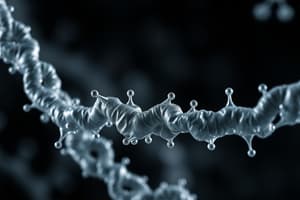Podcast
Questions and Answers
Which chemical reaction joins two monosaccharides to form larger carbohydrate molecules?
Which chemical reaction joins two monosaccharides to form larger carbohydrate molecules?
- Dehydration synthesis (correct)
- Hydrolysis
- Polymerization
- Oxidation
What is the main source of energy in all organisms?
What is the main source of energy in all organisms?
- Carbohydrates (correct)
- Proteins
- Nucleic Acids
- Lipids
What is the building block of proteins?
What is the building block of proteins?
- Monosaccharides
- Amino Acids (correct)
- Nucleotides
- Fatty acids
What is the chemical formula for monosaccharides?
What is the chemical formula for monosaccharides?
What functional group consists of a single nitrogen atom bonded to two hydrogen atoms?
What functional group consists of a single nitrogen atom bonded to two hydrogen atoms?
Flashcards are hidden until you start studying
Study Notes
Carbohydrates
- Condensation reaction, also known as dehydration synthesis, joins two monosaccharides to form larger carbohydrate molecules.
Energy Source
- ATP (Adenosine Triphosphate) is the main source of energy in all organisms.
Proteins
- Amino acids are the building blocks of proteins.
Monosaccharides
- The general chemical formula for monosaccharides is (CH2O)n, where n is the number of carbon atoms in the molecule.
Functional Groups
- Amino group, consisting of a single nitrogen atom bonded to two hydrogen atoms (NH2), is a functional group commonly found in biomolecules.
Studying That Suits You
Use AI to generate personalized quizzes and flashcards to suit your learning preferences.




